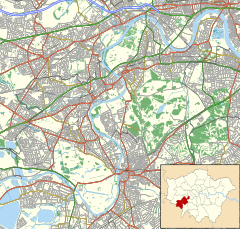후텡
Huteng후텡(간체 중국어: 胡腾; 전통 중국어: 胡騰; 핀인: 흐엉; 점등. '바바리안 도약', 또한 胡舞舞, 흐엉w, "바바리안 도약")은 중앙아시아에서 유래한 춤의 한 종류로, 특히 소그디아인과 타슈켄트 지역(石國, 시궈)에서 유래한 춤의 한 종류였다.[1] 이 춤은 당나라 때 잘 알려져 있었으며, 예술 작품에는 수많은 묘사가 있다. 춤은 빙글빙글 돌고, 도약하고, 백플립을 하는 것이 특징이었다.[1] 무용수들은 특히 서머스코트를 하는데, 처음에는 카펫에 발을 단단히 심고, 얼굴을 위로 기울이며 몸을 아치한 다음 팔을 들어 플룻 소리와 피파 소리에 맞춰 뒤로 뛰어오르곤 했다.[2]
Another famous dance from Central Asia was the Sogdian Whirl (胡旋, Húxuăn, "Whirling Barbarian", also 胡旋舞, Húxuănwǔ, "Dance of the Whirling Barbarian", sometimes rendered as "Whirling barbarian"[3][4] but known as "Sogdian Whirl dance" or simply "Sogdian whirl" to Western scholars[5]), in which a young woman was spinning inside a circle.[1] 또 다른 하나는 '가시나무 가지춤'(柘枝舞, Zzzhīwŭ)이었다.
중앙아시아, 세르디아, 페르시아 제국의 바르바리아 춤( (舞, Huwŭ)의 일부인 이 춤들은 당나라 때 특히 장안과 뤄양 지역에서 매우 인기가 있었다.[1][6]
외국인들의 표상은 8세기 이후 투르코-이란 반군인 안루산의 반란을 계기로 더욱 부정적으로 변하게 될 것이다.[7]
왼쪽: 과일 접시를 들고 있는 남자; 오른쪽: 수염을 기른 남자가 후텡 춤을 추고 있다. 두 인물 모두 후광이 있다. 유홍의 묘, 6세기 CE.
참고 항목
참조
- ^ a b c d The Silk Road Encyclopedia. Seoul Selection. 2016. p. 778. ISBN 9781624120763.
- ^ Trombert, Éric; Vaissière, Étienne de La (2005). Les sogdiens en Chine. École française d'Extrême-Orient. p. 96. ISBN 9782855396538.
- ^ Ning, Qiang (2004). Art, Religion, and Politics in Medieval China The Dunhuang Cave of the Zhai Family. University of Hawaiʻi Press. p. 126. ISBN 9780824827038.
- ^ Jeong, Su-il (2016). The Silk Road Encyclopedia. Seoul Selection. ISBN 9781624120763.
- ^ Furniss, Ingrid. "Retracing the Sounds of Sogdiana". Freer, Sackler - Smithsonian. Archived from the original on 11 September 2021. Retrieved 11 September 2021.
- ^ China Archaeology and Art Digest. Art Text (HK) Limited. 1997. p. 3.
- ^ Cosmo, Henry Luce Foundation Professor of East Asian Studies Nicola Di; Cosmo, Nicola Di; Wyatt, Don J. (2005). Political Frontiers, Ethnic Boundaries and Human Geographies in Chinese History. Routledge. p. 135. ISBN 9781135790950.




